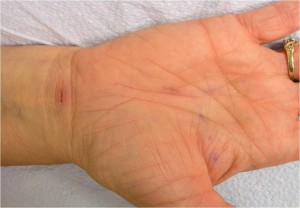PATIENT
EDUCATION
Carpal Tunnel Syndrome
What Is Carpal Tunnel Syndrome?
Carpal tunnel syndrome occurs when the median nerve, which runs through the wrist to the hand, becomes compressed. The problem involves the narrow bony passage in the wrist called the carpal tunnel, through which nine tendons and the median nerve must pass from the arm to the hand.
Carpal tunnel syndrome is a common condition that results in burning, numbness, or tingling in your fingers, thumb, palm, or wrist. You may find it difficult to grip objects, or you may wake at night with pain.
Symptoms
- Discomfort/aching in one or both hands
- Lack of feeling in the hand
- Wakening at night with pain
- Dropping objects more frequently
- Numbness/discomfort while gripping
Treatments for Carpal Tunnel Syndrome
There are nonsurgical and surgical treatment options available for carpal tunnel syndrome. Both treatment types are performed by our wrist specialist at Orthopaedic Specialists.
Nonsurgical Treatments
Mild cases of carpal tunnel syndrome may be treated with nighttime splints, anti-inflammatories, therapy, and/or cortisone injections. While nonsurgical treatment can relieve mild cases of the condition, surgery may be necessary if it continues to worsen.
Surgical Treatments

Endoscopic carpal tunnel release is a minimally invasive method of relieving carpal tunnel syndrome. During surgery, one small incision is made in the wrist and palm, through which an endoscope (small video camera) is inserted to view the surgery on a video monitor. A small knife is used to divide the tight tissue compressing the nerve. This method can result in a shorter recovery time compared to an open surgery but has a slightly increased risk of nerve damage. Patients are typically back to work one or two days following surgery with restrictions as necessary.
